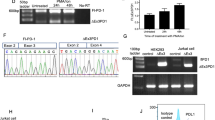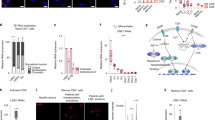Abstract
Objective
Immunotherapy targeting programmed cell death 1 (PDCD1 or PD-1) and its ligands has shown remarkable promise and the regulation mechanism of PD-1 expression has received arising attention in recent years. PDCD1 exon 3 encodes the transmembrane domain and the deletion of exon 3 produces a soluble protein isoform of PD-1 (sPD-1), which can enhance immune response by competing with full-length PD-1 protein (flPD-1 or surface PD-1) on T cell surface. However, the mechanism of PDCD1 exon 3 skipping is unclear.
Methods
The online SpliceAid program and minigene expression system were used to analyze potential splicing factors involved in the splicing event of PDCD1 exon 3. The potential binding motifs of heterogeneous nuclear ribonucleoprotein K (HNRNPK) on exon 3 predicted by SpliceAid were mutated by site-directed mutagenesis technology, which were further verified by pulldown assay. Antisense oligonucleotides (ASOs) targeting the exonic splicing silencer (ESS) on PDCD1 exon 3 were synthesized and screened to suppress the skipping of exon 3. The alternative splicing of PDCD1 exon 3 was analyzed by semiquantitative reverse transcription PCR. Western blot and flow cytometry were performed to detect the surface PD-1 expression in T cells.
Results
HNRNPK was screened as a key splicing factor that promoted PDCD1 exon 3 skipping, causing a decrease in flPD-1 expression on T cell membrane and an increase in sPD-1 expression. Mechanically, a key ESS has been identified on exon 3 and can be bound by HNRNPK protein to promote exon 3 skipping. Blocking the interaction between ESS and HNRNPK with an ASO significantly reduced exon 3 skipping. Importantly, HNRNPK can promote exon 3 skipping of mouse Pdcd1 gene as well.
Conclusions
Our study revealed a novel evolutionarily conserved regulatory mechanism of PD-1 expression. The splicing factor HNRNPK markedly promoted PDCD1 exon 3 skipping by binding to the ESS on PDCD1 exon 3, resulting in decreased expression of flPD-1 and increased expression of sPD-1 in T cells.





Similar content being viewed by others
Data availability
The datasets generated during the current study are available from the corresponding author on reasonable request.
References
Keir ME, Butte MJ, Freeman GJ, Sharpe AH. PD-1 and its ligands in tolerance and immunity. Annu Rev Immunol. 2008;26:677–704.
Boussiotis VA. Molecular and biochemical aspects of the PD-1 checkpoint pathway. N Engl J Med. 2016;375(18):1767–78.
Qin W, Hu L, Zhang X, Jiang S, Li J, Zhang Z, et al. The diverse function of PD-1/PD-L pathway beyond cancer. Front Immunol. 2019;10:2298.
Nielsen C, Ohm-Laursen L, Barington T, Husby S, Lillevang ST. Alternative splice variants of the human PD-1 gene. Cell Immunol. 2005;235(2):109–16.
Song MY, Park SH, Nam HJ, Choi DH, Sung YC. Enhancement of vaccine-induced primary and memory CD8(+) T-cell responses by soluble PD-1. J Immunother. 2011;34(3):297–306.
Liu C, Jiang J, Gao L, Wang X, Hu X, Wu M, et al. Soluble PD-1 aggravates progression of collagen-induced arthritis through Th1 and Th17 pathways. Arthritis Res Ther. 2015;17:340.
Greisen SR, Kragstrup TW, Thomsen JS, Hørslev-Pedersen K, Hetland ML, Stengaard-Pedersen K, et al. The programmed death-1 pathway counter-regulates inflammation-induced osteoclast activity in clinical and experimental settings. Front Immunol. 2022. https://doi.org/10.3389/fimmu.2022.773946.
Bommarito D, Hall C, Taams LS, Corrigall VM. Inflammatory cytokines compromise programmed cell death-1 (PD-1)-mediated T cell suppression in inflammatory arthritis through up-regulation of soluble PD-1. Clin Exp Immunol. 2017;188(3):455–66.
Curran CS, Gupta S, Sanz I, Sharon E. PD-1 immunobiology in systemic lupus erythematosus. J Autoimmun. 2019;97:1–9.
Falcone M, Fousteri G. Role of the PD-1/PD-L1 dyad in the maintenance of pancreatic immune tolerance for prevention of type 1 diabetes. Front Endocrinol. 2020;11:569.
Jia XH, Geng LY, Jiang PP, Xu H, Nan KJ, Yao Y, et al. The biomarkers related to immune related adverse events caused by immune checkpoint inhibitors. J Exp Clin Cancer Res. 2020;39(1):284.
Luoma AM, Suo S, Williams HL, Sharova T, Sullivan K, Manos M, et al. Molecular pathways of colon inflammation induced by cancer immunotherapy. Cell. 2020;182(3):655-71.e22.
Kobayashi M, Kawano S, Hatachi S, Kurimoto C, Okazaki T, Iwai Y, et al. Enhanced expression of programmed death-1 (PD-1)/PD-L1 in salivary glands of patients with Sjögren’s syndrome. J Rheumatol. 2005;32(11):2156–63.
Chen RY, Zhu Y, Shen YY, Xu QY, Tang HY, Cui NX, et al. The role of PD-1 signaling in health and immune-related diseases. Front Immunol. 2023;14:1163633.
Wan B, Nie H, Liu A, Feng G, He D, Xu R, et al. Aberrant regulation of synovial T cell activation by soluble costimulatory molecules in rheumatoid arthritis. J Immunol. 2006;177(12):8844–50.
Wu H, Chen L, Zhou X, Wu Y, Yan Y, Zhu Y, et al. Effect of tacrolimus on soluble costimulatory molecules in patients with refractory myasthenia gravis. J Neuroimmunol. 2022;372: 577955.
Sun J, Bai J, Jiang T, Gao Y, Hua Y. Modulation of PDCD1 exon 3 splicing. RNA Biol. 2019;16(12):1794–805.
Li D, Guo J, Jia R. Epigenetic control of cancer cell proliferation and cell cycle progression by HNRNPK via promoting exon 4 inclusion of histone code reader SPIN1. J Mol Biol. 2023;435(6): 167993.
Liu M, Lin C, Huang Q, Jia J, Guo J, Jia R. SRSF3-mediated Ki67 exon 7-inclusion promotes head and neck squamous cell carcinoma progression via repressing AKR1C2. Int J Mol Sci. 2023;24(4):3872.
Shepard P, Hertel K. The SR protein family. Genome Biol. 2009;10(10):242.
Geuens T, Bouhy D, Timmerman V. The hnRNP family: insights into their role in health and disease. Hum Genet. 2016;135(8):851–67.
Ito K, Sato K, Endo H. Cloning and characterization of a single-stranded DNA binding protein that specifically recognizes deoxycytidine stretch. Nucleic Acids Res. 1994;22(1):53–8.
Crooke ST, Baker BF, Crooke RM, Liang X-H. Antisense technology: an overview and prospectus. Nat Rev Drug Discov. 2021;20(6):427–53.
Xin X, Kumar V, Lin F, Kumar V, Bhattarai R, Bhatt VR, et al. Redox-responsive nanoplatform for codelivery of miR-519c and gemcitabine for pancreatic cancer therapy. Sci Adv. 2020. https://doi.org/10.1126/sciadv.abd6764.
Wang Z, Qiu H, He J, Liu L, Xue W, Fox A, et al. The emerging roles of hnRNPK. J Cell Physiol. 2020;235(3):1995–2008.
Khan M, Zhao Z, Arooj S, Fu Y, Liao G. Soluble PD-1: predictive, prognostic, and therapeutic value for cancer immunotherapy. Front Immunol. 2020;11:587460.
Shin S, Seo H, Shin J, Park H, Lim D, Eom H, et al. Adenovirus expressing both thymidine kinase and soluble PD1 enhances antitumor immunity by strengthening CD8 T-cell response. Mol Ther. 2013;21(3):688–95.
Liu C, Jiang J, Gao L, Wang X, Hu X, Wu M, et al. Soluble PD-1 aggravates progression of collagen-induced arthritis through Th1 and Th17 pathways. Arthrit Res Ther. 2015;17:340.
Turunen J, Niemelä E, Verma B, Frilander M. The significant other: splicing by the minor spliceosome. Wiley Interdiscip Rev-RNA. 2013;4(1):61–76.
Lee Y, Rio D. Mechanisms and regulation of alternative Pre-mRNA splicing. Annu Rev Biochem. 2015;84:291–323.
Wang Z, Qiu H, He J, Liu L, Xue W, Fox A, et al. The emerging roles of hnRNPK. J Cell Physiol. 2020;235(3):1995–2008.
Expert-Bezançon A, Le Caer J, Marie J. Heterogeneous nuclear ribonucleoprotein (hnRNP) K is a component of an intronic splicing enhancer complex that activates the splicing of the alternative exon 6A from chicken beta-tropomyosin pre-mRNA. J Biol Chem. 2002;277(19):16614–23.
Bampton A, Gatt A, Humphrey J, Cappelli S, Bhattacharya D, Foti S, et al. HnRNP K mislocalisation is a novel protein pathology of frontotemporal lobar degeneration and ageing and leads to cryptic splicing. Acta Neuropathol. 2021;142(4):609–27.
Chen R, Zhu Y, Shen Y, Xu Q, Tang H, Cui N, et al. The role of PD-1 signaling in health and immune-related diseases. Front Immunol. 2023;14:1163633.
Nishimura H, Nose M, Hiai H, Minato N, Honjo T. Development of lupus-like autoimmune diseases by disruption of the PD-1 gene encoding an ITIM motif-carrying immunoreceptor. Immunity. 1999;11(2):141–51.
Zamani M, Aslani S, Salmaninejad A, Javan M, Rezaei N. PD-1/PD-L and autoimmunity: a growing relationship. Cell Immunol. 2016;310:27–41.
Ding H, Wu X, Wu J, Yagita H, He Y, Zhang J, et al. Delivering PD-1 inhibitory signal concomitant with blocking ICOS co-stimulation suppresses lupus-like syndrome in autoimmune BXSB mice. Clin Immunol (Orlando, Fla). 2006;118:258–67.
Wang D, Tai P, Gao G. Adeno-associated virus vector as a platform for gene therapy delivery. Nat Rev Drug Discov. 2019;18(5):358–78.
Cooper TA. Use of minigene systems to dissect alternative splicing elements. Methods. 2005;37(4):331–40.
Kumar ARK, Shou Y, Chan B, Krishaa L, Tay A. Materials for improving immune cell transfection. Adv Mater. 2021. https://doi.org/10.1002/adma.202007421.
Coelho MB, Attig J, Bellora N, König J, Hallegger M, Kayikci M, et al. Nuclear matrix protein Matrin3 regulates alternative splicing and forms overlapping regulatory networks with PTB. Embo J. 2015;34(5):653–68.
Funding
This research was funded by the National Natural Science Foundation of China, grant number 81970933, the Fundamental Research Funds for the Central Universities, grant number, 2042023kfyq02 and the International Scientific Collaboration Project of Hubei Province, grant number 2022EHB036.
Author information
Authors and Affiliations
Contributions
Conceptualization, J.G. and R.J.; methodology, J.W. and L.Y.; validation, J.W. and L.Y.; formal analysis, J.W.; investigation, J.W. and L.Y.; resources, J.G. and R.J.; data curation, J.W. and L.Y.; writing—original draft preparation, J.W. and L.Y.; writing—review and editing, J.G. and R.J.; visualization, J.W.; supervision, J.G. and R.J.; project administration, J.G. and R.J.; funding acquisition, J.G. All authors have read and agreed to the published version of the manuscript.
Corresponding author
Ethics declarations
Conflict of interest
The authors declare no conflict of interest.
Ethical approval
Not applicable.
Additional information
Publisher's Note
Springer Nature remains neutral with regard to jurisdictional claims in published maps and institutional affiliations.
Supplementary Information
Below is the link to the electronic supplementary material.
Rights and permissions
Springer Nature or its licensor (e.g. a society or other partner) holds exclusive rights to this article under a publishing agreement with the author(s) or other rightsholder(s); author self-archiving of the accepted manuscript version of this article is solely governed by the terms of such publishing agreement and applicable law.
About this article
Cite this article
Wang, J., Yan, L., Wang, X. et al. Surface PD-1 expression in T cells is suppressed by HNRNPK through an exonic splicing silencer on exon 3. Inflamm. Res. (2024). https://doi.org/10.1007/s00011-024-01887-4
Received:
Revised:
Accepted:
Published:
DOI: https://doi.org/10.1007/s00011-024-01887-4




